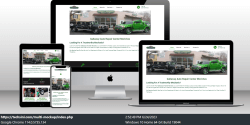Creating an effective small business website is crucial for your online success. It’s not just about having a digital presence; it’s an opportunity to connect with customers personally. To achieve this, you must focus on the ten essential elements that make a small business website exceptional.
Personalized and Engaging Design:
Your small business website design should reflect your unique brand personality with a clean and attractive layout. Utilize ample white space, incorporate captivating images, and aim for a professional look that sets you apart. Additionally, ensure your design is intuitive, making navigation effortless for visitors. Here are some key points to consider:
Personalized and engaging design is essential for a small business website as it sets the tone and creates a lasting impression on visitors. Here are some key points to consider:
- Brand Identity: Your website design should align with your brand identity and reflect the unique personality of your business. This includes using consistent color schemes, typography, and imagery that resonate with your target audience.
- Visual Appeal: A visually appealing design captures visitors’ attention and encourages them to explore further. Utilize high-quality images, graphics, and videos that enhance the overall aesthetics of your website and evoke the desired emotions.
- Clean Layout: A clean and organized layout makes navigating and finding the necessary information easier for visitors. Avoid clutter and excessive elements that may distract or overwhelm users.
- White Space: Incorporating ample white space (empty or blank space) around elements helps create a sense of balance and allows the content and visuals to breathe. This improves readability and makes the website appear more polished.
- Intuitive User Experience: Focus on creating a user-friendly experience by placing essential elements, such as navigation menus and contact information, in easily accessible locations. Consider user behavior and design your website to guide visitors seamlessly through the desired flow.
- Consistency: Maintain consistency throughout your website using the same design elements, fonts, and color palette across different pages. This helps reinforce your brand identity and creates a cohesive user experience.
- Usability: Ensure your website is easy to navigate and use across different devices and screen sizes. Incorporate intuitive navigation menus, clear headings, and logical page structures to help visitors find information effortlessly.
- Emotional Connection: A personalized design can create an emotional connection with your audience. Use visual elements and messaging that resonate with your target market, appealing to their preferences, values, and aspirations.
Remember, a personalized and engaging design goes beyond aesthetics. It should align with your business goals, effectively communicate your message, and provide a positive user experience that leaves a lasting impression on your visitors.
Mobile-Friendly Responsiveness:
With more people accessing the web on smartphones and tablets, optimizing your website for all devices is vital. A responsive design guarantees that your site functions seamlessly, regardless of the screen size, enhancing user experience and widening your reach.

User-Friendly Navigation:
Seamless navigation is critical to guiding visitors to their desired content quickly. Create a clear and logical navigation structure throughout your website, allowing users to find what they need effortlessly.
Compelling and Informative Content:
Alongside a visually appealing design, your website’s content is paramount. Engage your audience with informative and captivating text complemented by visually appealing elements like images and videos. Optimize your content for search engines to expand your visibility and attract a wider audience. Here are some key aspects to consider:
- Informative and Relevant: Your content should be informative, addressing the needs, interests, and pain points of your target audience. Offer valuable insights, tips, and relevant information that positions your business as an expert in your industry.
- Clear and Concise: Present your information clearly and concisely, using language that is easily understandable by your target audience. Avoid jargon or overly technical terms unless your audience specifically looks for that level of detail.
- Engaging and Compelling: Use storytelling techniques, engaging headlines, and persuasive language to capture visitors’ attention and keep them interested. Incorporate anecdotes, case studies, or real-life examples to make your content relatable and memorable.
- Visual Enhancements: Supplement your content with visually appealing elements such as high-quality images, videos, infographics, and charts. Visuals help break up text, make your content more engaging, and facilitate better comprehension.
- Search Engine Optimization (SEO): Optimize your content for search engines by incorporating relevant keywords strategically. Conduct keyword research to identify the terms and phrases your target audience is searching for and incorporate them naturally into your content.
- Easy-to-Scan Format: Format your content in a way that is easy to scan and digest. Use headings, subheadings, bullet points, and numbered lists to break up the text and make it more skimmable. This helps visitors quickly find the information they are looking for.
- Call-to-Action (CTA): Include clear and compelling calls-to-action within your content. Direct visitors to take the desired action, such as signing up for a newsletter, requesting a consultation, or purchasing. CTAs help guide visitors through the conversion process.
- Regular Updates: Keep your content fresh and up-to-date by regularly adding new articles, blog posts, or updates. This demonstrates your commitment to providing valuable information and helps improve your website’s search engine rankings.
Remember, compelling and informative content positions your business as a trusted resource and helps establish credibility with your audience. You can build trust, nurture relationships, and ultimately drive conversions and business growth by delivering high-quality content that meets their needs.
Clear Contact Information and Call-to-Action:
Make it easy for visitors to contact you or take the next step by prominently displaying your contact information and incorporating compelling call-to-action buttons, such as ‘contact us’ or ‘book now.’
Search Engine Optimization (SEO):
Boost your small business website visibility on search engines by implementing effective SEO strategies. Use relevant keywords in your content, optimize page titles and descriptions, and utilize ALT tags for images to improve your search engine rankings.
Seamless Social Media Integration:
Connect your website with social media platforms to foster engagement and attract potential customers. Include social media buttons on critical pages, allowing visitors to effortlessly like, share, or follow your brand. Keep your profiles updated and maintain an active presence for maximum impact.
![]()
Analytics and Tracking:
Gain valuable insights into your website’s performance by utilizing web analytics tools and tracking key metrics. Understand your audience, their origin, and how they interact with your site. Use this data to make informed decisions about your business’s direction.
Website Security and Privacy:
Prioritize your small business website’s security and privacy to protect yourself and your customers. Implement an SSL certificate to ensure a secure browsing experience and regularly maintain your site to mitigate potential threats.

Strive for Greatness:
Building a unique small business website requires time and effort. Remember that design, content, and usability are crucial factors. Take time to get everything right and implement a strategy aligning with your business goals. With dedication and careful execution, you can achieve online success and propel your business to new heights. I hope this article convinces you that building a small business website is a task for professional website designer that incorporates SEO techniques in their work.
<h2>Why Not Build Your Own Website?</h2>
Building your own website as a business owner can be tempting, but it’s important to consider the potential drawbacks and challenges of taking on this task without professional help. Here are some negative aspects to consider:
- Time-Consuming: Creating a website requires a significant investment of time. As a business owner, your time is valuable, and taking on web development and design responsibilities may divert your attention from core business activities.
- Steep Learning Curve: Building a professional website requires a solid understanding of web design principles, coding languages, and content management systems. Unless you have a background in web development, you may find it difficult to acquire the necessary skills and knowledge.
- Lack of Expertise: As a non-specialist, you may lack the expertise needed to create a visually appealing and user-friendly website. Design choices, layout decisions, and content presentation may not meet industry standards, resulting in a subpar user experience.
- Limited Customization: DIY website builders or templates often have limitations in terms of customization options. You may find it challenging to tailor your website to align with your unique brand identity and stand out from competitors.
- Lack of Functionality: Developing complex features and functionality may be beyond your capabilities. This can limit your website’s ability to deliver advanced functionalities, such as e-commerce, customer portals, or custom forms, which are vital for business operations.
- Limited Scalability: DIY websites may not have the scalability to accommodate future growth and evolving business needs. As your business expands, you may encounter difficulties in integrating new features or expanding your website’s capabilities.
- SEO Challenges: Achieving optimal search engine visibility requires a deep understanding of search engine optimization (SEO) techniques. Without expertise in this area, your website may struggle to rank well in search engine results, limiting organic traffic and online visibility.
- Maintenance and Updates: Websites require ongoing maintenance, security updates, and regular content updates. As a busy business owner, keeping up with these tasks can be burdensome and may lead to an outdated and vulnerable website.
- Lack of Professionalism: DIY websites may lack the polished and professional look that customers expect. A poorly designed or outdated website can negatively impact your brand image and credibility, potentially driving potential customers away.
- Potential Cost Overruns: While building your website may seem cost-effective initially, you may encounter unexpected costs. These can include purchasing premium themes or plugins, hiring professionals to fix errors or address technical issues, or investing in additional tools and resources to enhance your website’s functionality.
Ultimately, while the DIY approach may appear appealing from a cost-saving standpoint, it often leads to a subpar online presence. To ensure a professional, visually appealing, and functional website that effectively represents your business, it is often worth considering hiring a professional web developer or design agency to avoid the potential pitfalls of a self-built website.
Wix And Other DIY Website builders-Use Caution
Wix, touted as an easy-to-use website builder, may seem like a convenient choice for creating a professional website, but it comes with significant disadvantages that may hinder your online success. Let’s delve into the negative aspects of using Wix:
- Limited Customization: Wix’s customization options are constrained, preventing you from achieving a truly unique and tailored website. Your design choices are restricted to predefined templates and limited customization features, leading to a lack of originality.
- Rigidity and Difficulty in Modification: Once you’ve created your website on Wix, making substantial changes becomes arduous. The rigid structure and limited flexibility make adapting your website to evolving business needs or design preferences challenging.
- Compatibility Issues with Web Browsers: Wix websites may encounter compatibility problems across different web browsers. This can result in inconsistent rendering and functionality issues, alienating potential visitors who use browsers not fully supported by Wix.
- Steep Learning Curve and Lack of User-Friendliness: Wix’s user interface and navigation can be frustrating, particularly for beginners. Finding the necessary information or tools to create a website can be a time-consuming and bewildering process, requiring unnecessary effort.
- Lack of Professionalism and SEO Challenges: While Wix provides visually-appealing templates and professional-looking images, the drawback is that many users rely on the same generic images. This leads to a proliferation of duplicate content, which hampers your website’s visibility in search engine rankings. It’s rare to find Wix websites ranking on the first page of Google search results, severely limiting your online exposure and defeating the purpose of having a website.
- Ownership and Portability Limitations: Perhaps the most critical drawback of using Wix is the fact that you don’t truly own your website. Wix retains ownership, preventing you from making a copy of your work or moving it to a different hosting provider. This lack of control and portability can be detrimental to your business in the long run.
- Influenced by Affiliate Commissions: The endorsements you see for Wix and similar do-it-yourself website companies may be driven by financial incentives. Many individuals promoting these platforms are motivated by the high affiliate commissions they receive rather than the genuine effectiveness of the service.
Considering these drawbacks, it becomes clear that relying on a professional website designer with SEO expertise is a wiser choice. By focusing on your core business and entrusting website development to professionals, you can ensure a customized, high-performing website that aligns with your specific goals and enhances your online presence.








